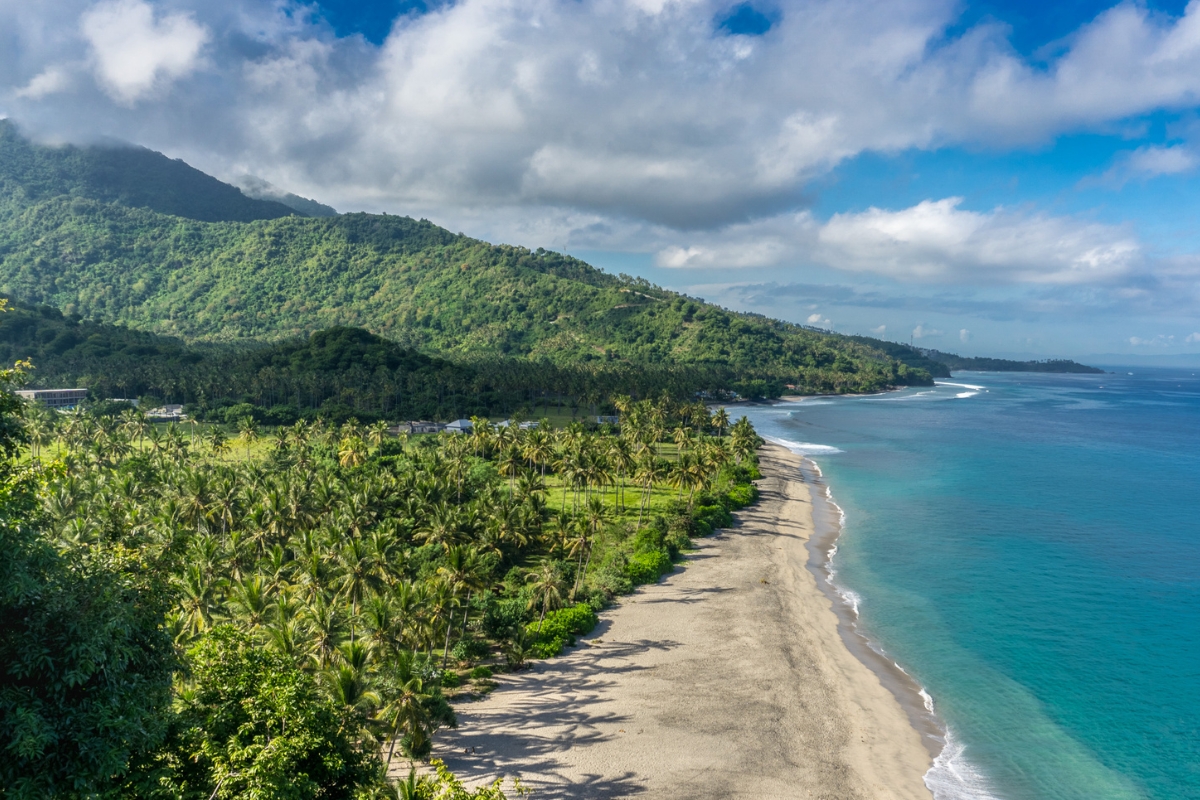Lombok, Indonesia’s gem neighboring Bali, is celebrated for its pristine beaches, majestic mountains, and rich cultural traditions. Whether you’re planning a surfing adventure, a trekking expedition up Mount Rinjani, or simply looking for a serene escape from the bustling tourist hotspots, this guide will help you decide the best time to visit Lombok. We’ll explore Lombok’s climate, monthly weather patterns, tourist trends, cost factors, and local experiences so you can determine when to go to Lombok for an unforgettable trip.
1. Introduction
Lombok offers an enchanting mix of natural beauty and cultural authenticity. From its powdery white-sand beaches and crystal-clear waters to its lush landscapes and traditional Sasak villages, the island caters to every type of traveler. Many visitors often ask, “what is the best time to visit Lombok?” or “when to go to Lombok” to make the most of their trip. This guide provides detailed insights into seasonal weather, tourist dynamics, pricing, and unique local experiences to help you decide on the best month on Lombok for your ideal getaway.
2. Understanding Lombok’s Climate
General Weather Patterns
Lombok enjoys a tropical climate with two primary seasons:
- Dry Season (May to September):
During these months, expect clear skies, low humidity, and minimal rainfall. The dry season is ideal for beach activities, water sports, and outdoor adventures like hiking Mount Rinjani. - Wet Season (October to April):
The wet season brings higher humidity and frequent rain showers, which can be heavy at times. While the rain contributes to the island’s lush greenery, it might disrupt outdoor plans and water activities.
Seasonal Variations
Since temperatures remain fairly constant year-round—typically between 25°C and 32°C (77°F to 90°F)—the differences lie mainly in the amount of rainfall. Coastal areas shine during the dry season, while the inland regions and waterfalls are at their most vibrant during the wet season. Deciding the best time to visit Lombok depends on your interests: whether you prioritize sunny beach days and clear waters or lush, dramatic landscapes and fewer crowds.
3. Monthly Weather Breakdown
Rainfall and Temperature Trends
- May to September (Dry Season):
This period is the most popular for visitors, as the weather is predictably sunny and dry. Temperatures are warm, making it perfect for swimming, snorkeling, and surfing along Lombok’s beautiful coastlines. - October (Shoulder Season):
Many travelers consider October to be the best month on Lombok. During this transitional month, the weather is still warm and pleasant with fewer tourists, offering a balanced experience of sunny days and manageable rainfall. - November to April (Wet Season):
These months see higher rainfall, particularly from December to February. While the lush greenery and dramatic waterfalls make for a stunning backdrop, outdoor activities may be interrupted by occasional heavy showers.
Impact on Outdoor Activities
- Beach and Water Sports:
The dry season provides ideal conditions for all kinds of water activities, from diving and snorkeling to surfing. - Trekking and Exploring:
For those interested in hiking or exploring cultural sites, the shoulder season offers a comfortable climate with fewer crowds. - Cultural Experiences:
Although the wet season can bring refreshing rains, it might limit outdoor excursions. However, it’s a great time to enjoy indoor activities, local cuisine, and cultural festivals.
4. Tourist Seasonality and Trends
Monthly Tourist Numbers
- Peak Season (May to September):
The dry season attracts the most visitors, with bustling beaches and fully booked resorts. This period is ideal if you want guaranteed sunshine, but it comes with higher prices and larger crowds. - Shoulder Season (October):
October stands out as a favorite for many travelers. With pleasant weather and fewer tourists, it offers a more relaxed atmosphere while still providing ample opportunities for outdoor adventures. - Low Season (November to April):
The wet season sees fewer tourists, resulting in quieter beaches and more personalized service. This is an excellent option for budget-conscious travelers who don’t mind occasional rain.
Advantages and Disadvantages
Peak Season:
- Advantages:
- Excellent weather for outdoor and water activities.
- A wide range of events, tours, and services available.
- Disadvantages:
- Higher prices and crowded attractions.
- Requires early booking for accommodations and tours.
Shoulder Season:
- Advantages:
- Pleasant weather with a moderate number of tourists.
- Better pricing and a more relaxed atmosphere.
- Often regarded as the best month on Lombok by those looking for a balanced experience.
- Disadvantages:
- Transitional weather might be slightly unpredictable at times.
Low Season:
- Advantages:
- Lower costs for flights and accommodations.
- A quieter, more intimate travel experience.
- Disadvantages:
- Increased likelihood of rain may disrupt outdoor plans.
- Some services might be less available.
5. Cost Considerations for Travelers
Accommodation Pricing Trends
Lombok offers a range of lodging options—from luxurious beachfront resorts and private villas to budget-friendly guesthouses:
- Peak Season:
Expect premium rates during the dry season due to high demand. - Shoulder Season:
Many properties offer attractive deals during October, making it an appealing time for travelers seeking a balanced experience. - Low Season:
This period features significantly lower prices, ideal for those looking to save money, though with a trade-off in terms of weather reliability.
Flight and Transport Costs
Airfares and local transportation costs vary with the season:
- Peak Season:
Higher demand means higher prices for flights and transfers. - Shoulder and Low Seasons:
Reduced tourist numbers typically lead to discounted fares and special promotions, offering greater value for budget travelers.
Budgeting Tips
- Book Early:
Reserve flights and accommodations in advance to secure the best rates. - Use Comparison Tools:
Online travel platforms and fare alerts are essential for finding competitive deals. - Consider Package Deals:
Bundled packages that include flights, transfers, and tours can offer significant savings. - Stay Flexible:
Adjust your travel dates if possible to capitalize on lower rates during shoulder or low seasons.
6. Other Essential Factors
Local Events and Cultural Experiences
Lombok is rich in local culture and traditional festivities:
- Cultural Festivals:
Experience traditional Sasak music, dance, and crafts at local festivals and markets. - Culinary Delights:
Enjoy fresh seafood, spicy local dishes, and traditional Indonesian cuisine in both upscale restaurants and street-side eateries. - Historical Sites:
Visit ancient temples, local villages, and the stunning Gili Islands nearby for a taste of Lombok’s heritage.
Water Conditions for Beach and Water Sports
- Dry Season:
With calm and clear waters, the dry season is ideal for swimming, snorkeling, and diving. - Wet Season:
While occasional rain showers can occur, dry spells still allow for plenty of water-based activities.
Special Offers and Packages
Watch for seasonal promotions:
- Discounted Rates:
Many resorts offer special deals during the shoulder and low seasons. - Value-Added Packages:
Bundled offers that include tours, meals, or spa treatments can enhance your overall experience. - Last-Minute Offers:
Flexibility with travel dates may enable you to take advantage of attractive last-minute deals.
7. Comparative Analysis: Finding the Best Month
Choosing the best time to visit Lombok depends on your travel priorities:
- For Beach Lovers and Water Sports Enthusiasts:
The dry season (May to September) provides the best conditions for enjoying Lombok’s beaches and marine activities. This period is often considered when you’re asking, “what is the best time to visit Lombok?” for a classic tropical getaway. - For Cultural Explorers and Budget Travelers:
The shoulder season, particularly October, is frequently hailed as the best month on Lombok. With warm weather, fewer crowds, and better prices, October offers a balanced experience ideal for both relaxation and exploration. - For a Quiet, Intimate Experience:
The low season (November to April) offers lower costs and a more serene environment, though you may need to plan around occasional rain.
8. Tips for a Successful Trip
Planning and Booking Strategies
- Book Early:
Secure your flights, accommodations, and tours well in advance if you plan to travel during the peak season. - Use Comparison Tools:
Online travel agencies and fare alerts are invaluable for finding the best deals. - Stay Flexible:
Adjust your travel dates to take advantage of lower rates during the shoulder or low seasons. - Seek Local Insights:
Engage with travel forums and local guides to discover hidden gems and current conditions on Lombok.
What to Pack for Different Seasons
- Dry Season Essentials (May to September):
Pack light, breathable clothing, swimwear, sunglasses, a wide-brimmed hat, and high-SPF sunscreen. Include comfortable beach sandals and a cover-up for evenings. - Shoulder Season Essentials (October):
Bring layers such as light jackets or cardigans for cooler mornings and evenings, along with comfortable walking shoes. - Low Season Essentials (November to April):
In addition to tropical attire, pack a waterproof jacket or umbrella and quick-dry clothing to manage occasional rain showers.
Insider Advice for Visitors
- Local Transportation:
Options include taxis, motorbike rentals, and organized tours. Hiring a local guide can enrich your cultural experience. - Dining:
Enjoy local dishes at both upscale restaurants and traditional warungs. Sampling authentic Sasak cuisine is a must. - Cultural Etiquette:
A friendly greeting and respectful curiosity about local traditions go a long way in enhancing your travel experience. - Health and Safety:
Lombok is generally safe for travelers, but standard precautions—such as staying hydrated, using sun protection, and securing your belongings—are always recommended.
9. Conclusion
Determining when to go to Lombok depends on your travel priorities. If you’re looking for uninterrupted beach days, excellent water sports, and a lively tourist atmosphere, the dry season (May to September) is your best choice. For a more balanced experience that combines pleasant weather, fewer crowds, and attractive pricing, many travelers agree that October is the best month on Lombok. Whether you’re seeking adventure, cultural immersion, or simply a tranquil escape, Lombok promises an unforgettable Indonesian getaway.
By considering Lombok’s climate, seasonal trends, cost factors, and local experiences, you can design an itinerary that perfectly matches your dream vacation. Happy travels, and enjoy your journey to this enchanting island!
10. Frequently Asked Questions (FAQ)
Q: When is the best time to visit Lombok?
A: The best time to visit Lombok is generally during the dry season (May to September) for ideal beach and water sports conditions.
Q: When to go to Lombok if I want fewer crowds and better prices?
A: The shoulder season, particularly October, is a great time to go to Lombok, offering pleasant weather, fewer tourists, and attractive rates.
Q: What is considered the best month on Lombok?
A: Many travelers find that October is the best month on Lombok, as it provides a balanced mix of warm weather, lower crowds, and excellent value.
Q: Are there significant price differences between seasons in Lombok?
A: Yes. Peak season (dry season) sees higher prices for flights and accommodations, while the shoulder and low seasons offer more competitive rates.
Q: Is Lombok suitable for both beach lovers and cultural explorers?
A: Absolutely. Lombok offers pristine beaches and excellent water sports during the dry season, along with rich local culture, traditional cuisine, and historical sites for cultural exploration.

